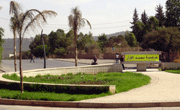| Titre : | The Mobility Of Displaced Syrians : An Economic And Social Analysis | | Type de document : | texte imprimé | | Auteurs : | World Bank, Auteur | | Editeur : | The World Bank | | Importance : | 322p. | | Format : | 24 cm | | Langues : | Français (fre) | | Mots-clés : | Syria social problems | | Index. décimale : | 362 Problèmes et services d'aide sociale | | Résumé : | The war in Syria, now in its eighth year, continues to take its toll on the Syrian people. More than half of the population of Syria remains displaced; 5.6 million persons are registered as refugees outside of the country and another 6.2 million are displaced within Syria's borders. The internally displaced persons include 2 million school-age children; of these, less than half attend school. Another 739,000 Syrian children are out of school in the five neighborhood countries that host Syria's refugees. The loss of human capital is staggering, and it will create permanent hardships for generations of Syrians going forward.
Despite the tragic prospects for renewed fighting in certain parts of the country, an overall reduction in armed conflict is possible going forward. However, international experience shows that the absence of fighting is rarely a singular trigger for the return of displaced people. Numerous other factors--including improved security and socioeconomic conditions in origin states, access to property and assets, the availability of key services, and restitution in home areas--play important roles in shaping the scale and composition of the returns. Overall, refugees have their own calculus of return that considers all of these factors and assesses available options. |
The Mobility Of Displaced Syrians : An Economic And Social Analysis [texte imprimé] / World Bank, Auteur . - [S.l.] : The World Bank, [s.d.] . - 322p. ; 24 cm. Langues : Français ( fre) | Mots-clés : | Syria social problems | | Index. décimale : | 362 Problèmes et services d'aide sociale | | Résumé : | The war in Syria, now in its eighth year, continues to take its toll on the Syrian people. More than half of the population of Syria remains displaced; 5.6 million persons are registered as refugees outside of the country and another 6.2 million are displaced within Syria's borders. The internally displaced persons include 2 million school-age children; of these, less than half attend school. Another 739,000 Syrian children are out of school in the five neighborhood countries that host Syria's refugees. The loss of human capital is staggering, and it will create permanent hardships for generations of Syrians going forward.
Despite the tragic prospects for renewed fighting in certain parts of the country, an overall reduction in armed conflict is possible going forward. However, international experience shows that the absence of fighting is rarely a singular trigger for the return of displaced people. Numerous other factors--including improved security and socioeconomic conditions in origin states, access to property and assets, the availability of key services, and restitution in home areas--play important roles in shaping the scale and composition of the returns. Overall, refugees have their own calculus of return that considers all of these factors and assesses available options. |
|


 Affiner la recherche
Affiner la rechercheHIV/AIDS in the Middle East and North Africa / Carol Lynn Jenkins
The Mobility Of Displaced Syrians / World Bank




